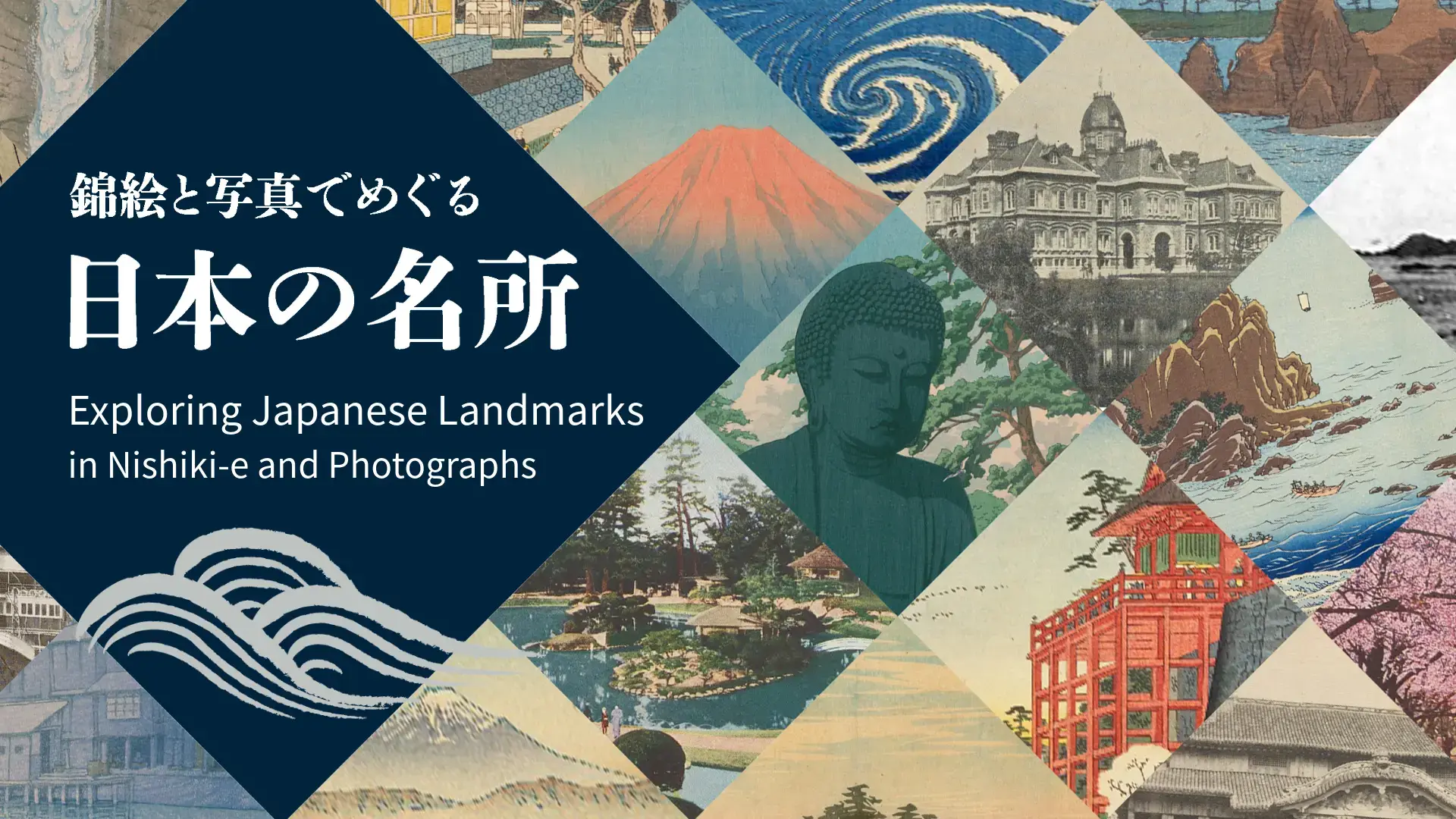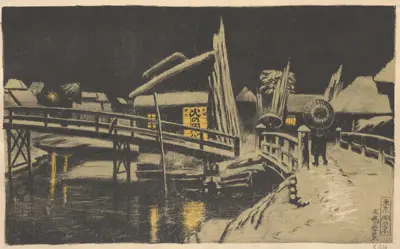
道頓堀あたり
このコラムは、平成20年に電子展示会「写真の中の明治・大正(大阪編)」の中で公開したコラムを移行したものです。内容は当時の記載内容に基づきます。
芝居の町
慶長17(1612)年から元和元(1615)年にかけて開削された道頓堀川。寛永3(1626)年、この地に最初の芝居小屋ができて以来、道頓堀と言えば芝居であった。最盛期には歌舞伎6座、浄瑠璃5座、説経7座、からくり1座、舞4座が立ち並んだという。川に面しては芝居茶屋も軒を連ね、江戸時代を通じて大坂随一の遊興の地だった。芝居小屋に浮沈はあり、火災にも見舞われたが、中座・角座・戎(えびす)座・弁天座・朝日座の5座を中心に、明治に入っても道頓堀の芝居の賑わいは続く。「......五箇所の劇場年中絶ず興行して大入の札を掲げり。又、落語、新内節(しんないぶし)、女浄瑠璃の席あり。劇場の間々の地及び河岸には芝居茶屋、割烹亭、飲食物舗、諸商家も連絡(つらな)り......」(榊原栄吉編『市内漫遊大阪名所図絵』明治23年刊)と描写されたのが明治半ば。その後、新派や喜劇など芝居が多様化し、活動写真という新しい娯楽も出現したが、道頓堀の賑わいの中心には常に芝居があった。
明治末年、ちょうど掲出写真が撮影された時期の道頓堀の様子を、大阪出身の評論家、高須芳次郎(梅渓、1880-1948)は愛着を込めて次のように綴っている。「......道頓堀の附近には、自分の身心を魅する多くの歓楽的分子がある。古名優の面影をその儘に見るやうな雁次郎の芝居を始め四、五の劇場が昔のまゝの古い櫓(やぐら)を聳(そび)やかして、幟、旗、小提灯等、大阪風の強烈な色彩に塗抹(とまつ)された絵看板と共に、妙に人を誘(そそ)る。而して劇場の前に列(なら)んだ芝居茶屋の細長い角行燈や、芝居と芝居の間に散在する旗亭(きてい)や、小料理屋や、『まむし』とか『小田巻』とか書いたウドン屋の看板や、冬には蒸寿司を売る鮨屋や鯛味噌を売る丸萬の蒲鉾店や何れも大阪特有の地方色を帯びた家が、東京に馴れた者の眼には、何となく妙奇心を動かす原因となつて、鋭く、味覚、色覚を刺戟する......」(高須梅渓『スケッチ文集』明治45年刊)
芝居の比重が著しく低下してしまった今日の道頓堀では、「大阪風の強烈な色彩に塗抹された絵看板」や「鋭く、味覚、色覚を刺戟する」風景のみが、否応なく単独で前面に押し出されているきらいがある。しかし、それは本来、芝居町の情緒あふれる道頓堀の原風景の中に存在していた。強烈ではあるがどことなく柔らかで落ち着いた風情が、当時の写真からは感じられる。
芝居の舞台―「いくたま」「こうづ」
道頓堀は、芝居の町であると同時に芝居の舞台そのものだった。
例えば、人形浄瑠璃。道頓堀の竹本座や豊竹座で上演されたそれらの作品には、道頓堀とその周辺の場所がしばしば登場する。それゆえ、道頓堀での芝居見物には、「活きた背景の中に居るのであるから、其の感じ方が一層シンミリとする」(高須前掲書)格別の味わいがあった。
道頓堀近辺には寺社も多い。とりわけ、歩いて10分ほどのところにある生国魂(生玉、いくたま)神社と高津(こうづ)神社(高津宮)は市内有数の神社である。今日でも、道頓堀の喧騒とは全く無縁の驚くほどの静寂が、その境内を包んでいる。そして、そこは芝居の舞台でもあった。数多い浄瑠璃作品からそれぞれ一例のみ挙げれば、近松門左衛門の心中物の第一作『曽根崎心中』の発端「生玉社前の段」はまさにこの生国魂神社での出来事であり、歌舞伎でも人気の高い『夏祭浪花鑑』は、高津神社の夏の例祭を物語全編に絡ませている。
生国魂神社の祭神は生国魂大神(生嶋神)と足国魂大神(足嶋神)、延喜式内の古社であり、豊臣秀吉によって現在の地に移された。大坂の総鎮守神として古くから人々の信仰が篤かった。高津神社の祭神は仁徳天皇ほか6座、境内はもともと聖徳太子が仁徳天皇の神廟を建立したところと伝えられる。こちらも人々の信仰が篤く、梅の名所としても知られていた。
両神社はまた、眺望の良さでも有名だった。掲出写真が撮影された頃の大阪名所案内の一つ、道楽山人編『大阪名勝記』(明治34年刊)は、生国魂神社について「本社の後背(うしろ)には懸崖の上に舞台あり、望遠鏡(とほめがね)を備へて眺望せしむ。之より望めば全市万戸の甍を一望し、遥に淡路島及び播摩の山を見る」、高津神社について「社地は道頓堀の東に在り、一堆(たい)の丘阜(きゅうふ)にして......本社の西には舞台ありて眺望絶佳なり。道頓堀の繁華を下瞰し、遠く全市及び海面を望む」と記している。
今日では、すぐそばまでビルやマンションが迫り、いずれも境内からの眺望は全く望めない。しかし高層建築物のなかった明治時代の眺望は、例えば高津神社について、渡辺忠久画『大阪名所』(明治24年刊)や瀬川光行編『日本之名勝』(明治33年刊)など、当時の絵や写真から容易に想像することができる。
眺望の良さは、上町台地の西端という立地に由来する。ちなみに、上町台地の西端は、高津神社や生国魂神社の周辺から四天王寺まで、北から南へ寺町が続く。都心部としては緑が多く、今日でも思いがけない情緒が残っていたりする。この付近にも、芝居の舞台となっている場所は多い。芝居好きのそぞろ歩きには打って付けの、都心の穴場である。
生国魂神社の社殿は明治45(1912)年の南区大火でほとんどが焼失、まもなく再建されたが、昭和20(1945)年戦火で再び焼失し、戦後再復興された。高津神社の社殿も、戦災に遭い、戦後復興されている。コンクリートで再建された社殿に情緒を感じるのは難しいかもしれない。しかし、その気になって歩けば、お初徳兵衛や団七九郎兵衛や釣船三婦は、今もこの町に生きているのである。
注:引用文は旧字体を新字体に改め、句読点等を施した。
引用・参考文献
- 榊原英吉編『市内漫遊大阪名所図絵』藜光堂,明治23(1890) 【特61-720】
- 高須梅渓『スケッチ文集:美文評論』岡村盛花堂,明治45(1912) 【特63-770】
- 道楽山人編『大阪名勝記:附・近傍名所案内』小谷卯三郎,明治34(1901) 【29-274】
- 渡辺忠久画『大阪名所』渡辺忠久,明治24(1891) 【特54-973】
- 瀬川光行編『日本之名勝』史伝編纂所,明治33(1900) 【403-76】
- 木谷蓬吟『道頓堀の三百年』新大阪出版社,1947 【774.2-Ki315d】
- 三田純市『道頓堀:川・橋・芝居』白川書院,1975 【KD815-18】
- 『道頓堀展:描かれたなにわの華:平成15年度大阪府立中之島図書館特別展示』大阪府立中之島図書館,2003 【Y121-H1615】
- 宗政五十緒編『上方風俗大阪の名所図会を読む』東京堂出版,2000 【GC161-G25】
- なにわ物語研究会編『大阪まち物語』創元社,2000 【GC163-G35】
- 大阪府学務部編『大阪府史蹟名勝天然記念物.第5冊』清文堂出版,1974 (昭和6年刊の複製) 【GC161-21】
- 新修大阪市史編纂委員会編『新修大阪市史.第5-6巻』大阪市,1991-1994 【GC163-E5】
- 国史大辞典編集委員会編『国史大辞典』吉川弘文館,1979-1997 【GB8-60】
- 『世界大百科事典.20(トウケ‐トン)』2005年改訂版.平凡社,[2005] 【UR1-H84】







